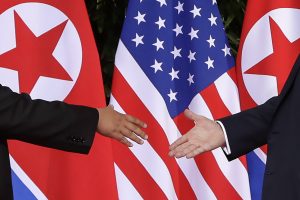Diplomacy between the United States and North Korea continues to run into obstacles.
On Thursday, North Korean negotiators ghosted their U.S. counterparts at the Korea Demilitarized Zone’s Joint Security Area. Both sides were slated to convene working group-level talks to make progress on one of the four major outcomes of the June 12 Singapore summit between U.S. President Donald J. Trump and North Korean leader Kim Jong Un: the repatriation of U.S. Korean War-era prisoner-of-war/missing-in-action remains.
As far as it goes as a negotiating tactic, North Korea’s reluctance to show up for scheduled talks is well-documented. A protocol and logistics delegation from the White House was stood up in Singapore in the weeks leading up to the Trump-Kim summit as well. Whether the move is perceived to create leverage or simply frustration, North Korean diplomats and officials choose to regularly employ it. A North Korean no-show isn’t unusual.
But this week’s example comes amid a confluence of negativity in the post-Singapore bilateral mood between Pyongyang and Washington, spurred primarily by the recent visit by U.S. Secretary of State Mike Pompeo to Pyongyang, which I discussed in greater detail earlier this week. It also follows public accusations by the United States that China and Russia had provided North Korea with refined petroleum in violation of United Nations Security Council Resolutions.
The process between the two sides isn’t collapsing just yet, but the signs of tension are apparent to anyone looking closely. North Korea is intent on still talking to the United States in the spirit of the Singapore declaration, which means setting aside the issue of unilateral disarmament.
On the other side from all of the above is Trump’s Thursday tweet, which shared a letter sent to him by Kim Jong Un and claimed that “great progress” was underway with North Korea. The sentiment expressed in the tweet underlines that Trump remains determined to delude himself into a sense of progress where none exists — just as he declared an end to the North Korean nuclear threat on his return from the June 12 summit in Singapore.
More importantly, the letter from Kim, written for Trump before it became clear to North Korea that Pompeo’s visit would be an unproductive farrago, is full of flattery. If the North Korean leader has learned anything about the state of the United States’ foreign policy-making apparatus in 2018, it’s that no matter how he treats Trump’s deputies, as long as he flatters the president himself, he can continue to enjoy positive momentum.
Kim may have miscalculated, though. Sooner or later, it will become clear to Trump that Kim is not intending to give up his nuclear weapons. That’s where things between the United States and North Korea could begin to get quite hairy and potentially plunge us right back into the crisis of late-2017.

































